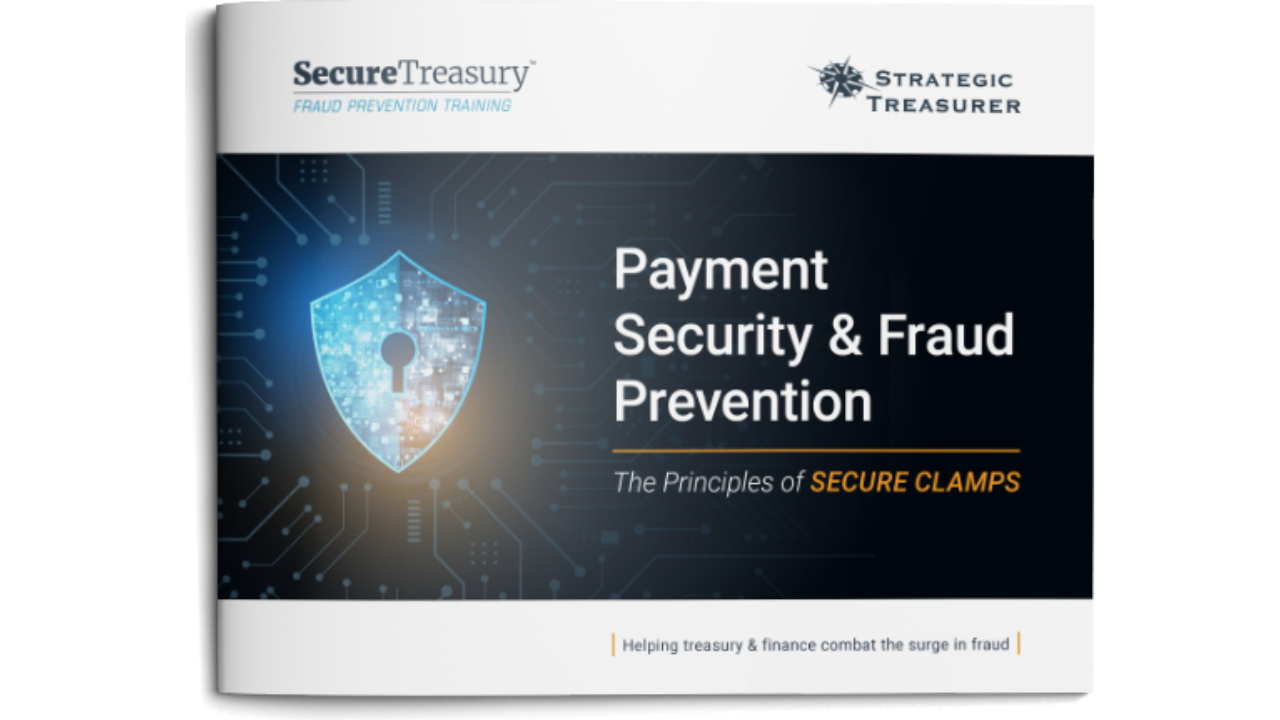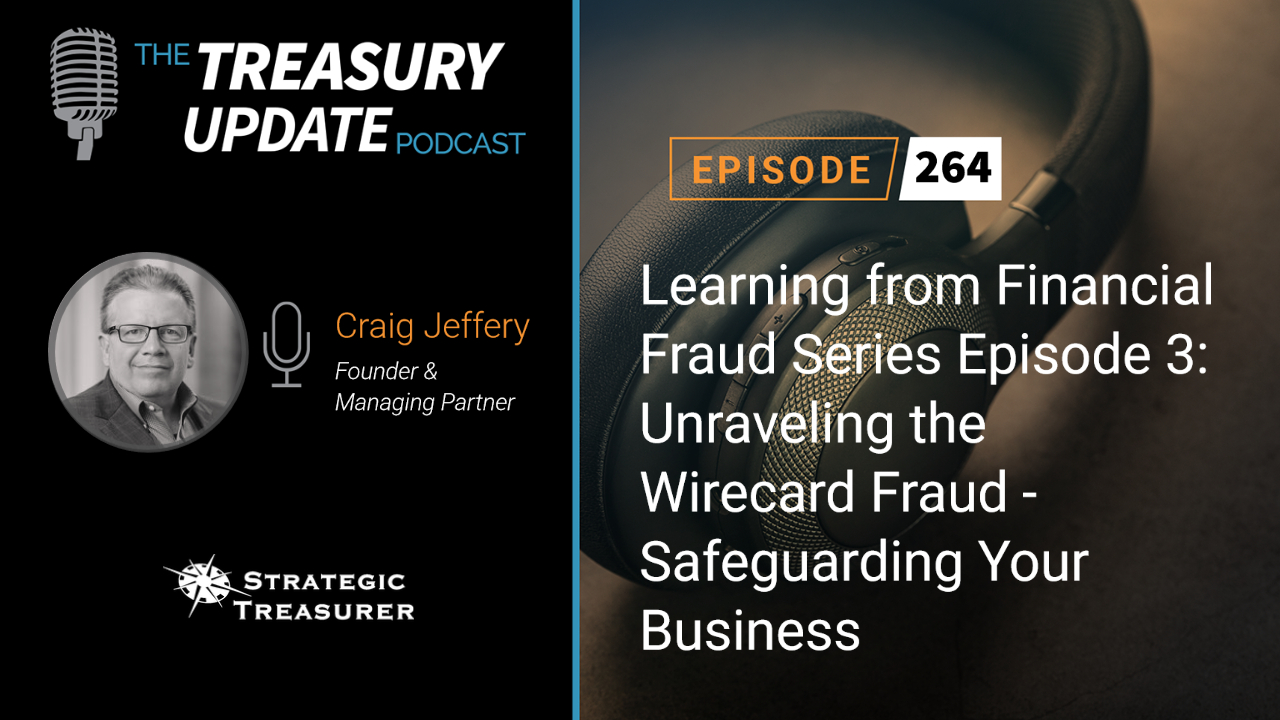
Episode 265
Learning from Financial Fraud Series Episode 4: Unmasking the FTX Fraud & Safeguarding Your Assets
Welcome back to the “Learning from Financial Fraud” series. Listen in as Jonathan and Craig from Strategic Treasurer delve into the FTX scandal, a recent case involving FTX Trading Ltd. Learn about the charges faced by Mr. Sam Bankman-Fried for the alleged misappropriation of customer funds.
This discussion includes vital safeguards and the issue of insider fraud – a challenge that surrounds us all.
Learn more about how you can safeguard your company by clicking HERE
Follow these links to hear the other podcasts in the Learning from Financial Fraud Series:
Host:
Jonathan Jeffery, Strategic Treasurer


Speaker:
Craig Jeffery, Strategic Treasurer


Subscribe to the Treasury Update Podcast on your favorite app!
Episode Transcription - Episode # 265: Learning from Financial Fraud Series, Episode 4: Unmasking the FTX Fraud and Safeguarding Your Assets
Announcer 00:04
Welcome to the Treasury Update Podcast presented by Strategic Treasurer, your source for interesting treasury news, analysis, and insights in your car, at the gym, or wherever you decide to tune in.
Jonathan Jeffery 00:18
Welcome back to the Treasury Update Podcast, you’re listening to the Learning from Financial Fraud series. In this series, we explore multiple major financial fraud cases, we discuss how each one occurred and was kept hidden for a period of time. And we’ll dissect how it was eventually discovered, and get insights and guidance on how to prevent these types of situations from happening to you and your organization. I’ll be your host today, Jonathan, media production specialist here at Strategic Treasurer. And I’m here with Craig Jeffery, our local fraud expert.
Craig Jeffery 00:52
Thanks for the superlatives at the front of that introductions. Jon, I’m looking forward to this continued discussion and dialogue on these fraud cases. They’re, they’re fascinating, they’re scary, and they’re instructive in a lot of ways.
Jonathan Jeffery 01:06
Cool. Well, let’s start off with a recap of what we’ve covered. So far. In this series, we’ve covered three different fraud scandals. The first one was Parmalat, and then Satyam, and Wirecard. Craig, can you give a recap of these three situations?
Craig Jeffery 01:20
Yeah, for those who read the footnotes, like when they see a footnote, and they actually read the entire footnote, they go pull it out and read the entire book. We invite you to listen to the other podcasts on these Parmalat was guilty of falsifying records, their big dairy company, they fooled auditors, including fooling them to the tune of $4 billion through one bank. And that’s an interesting story. What happened there in the loss was quite a bit more than that. Satyam was an Indian company, it all kinds of fictitious accounts that were created, particularly creating fictitious employees, which they use to siphon off funds. This was a huge, you know, more than a billion dollar fraud. And this was found by a confession letter, one of the perpetrators wrote a confession letter, easing their conscience, but bringing this to light. If you have fake employees, they’re not going to be reporting you employees that don’t exist can report things that’s, that’s certainly true. But others might people running payroll or are seeing some anomalous things like where’s the manager? How does that how does that roll in Wirecard. Wirecard is a big payment company global payment company. And they have this process, you might kind of it’s similar, people should think of as similar to kiting, they were moving money around their global organization. And then let’s say you move 500 million to this one account and you move it to another account. And you take a snapshot on the different days, it’s like, Okay, I’ve got 500 million in six accounts that looks like I have 3 billion, but they’re on different days or different periods of time. And that was coupled with pretty extensive collusion and falsification of records. So those are three pretty significant ones all about 10 years apart. When was the most recent of those three Wirecard. That’s just a few years ago. 2020, I think is when it really came to light.
Jonathan Jeffery 03:16
Okay, so a couple years ago, and today, we are moving on to the fourth episode in this series, and we’re going to be talking about a case that is still underway. We’re going to be looking at the FTX scandal. It’s a very recent case where Mr. Sam Brinkman fried He’s the founder of FTX, he was accused of cheating investors out of billions of dollars, and making illegal campaign donations. This caused a bunch of fear in the crypto markets and caused FTX to collapse and a couple different bankruptcies, I think in in FTX, and and a couple other companies, correct, what is FTX? What’s their primary function and what service that they provide?
Craig Jeffery 03:55
So FTX was a digital trading platform. So they would help people trade currencies, they would create the various tokens that showed value so people could invest in digital currency through this platform. They also act as a bit of a column a savior for this whole industry. They bought competitors that ran into trouble. So as people are having trouble, they bought liquid global blockfolio ledger X that kind of rescued these, these funds when they had had problems. So they were seen as, Hey, anybody runs into problems, FTX can make this work.
Jonathan Jeffery 04:32
So how did these accusations come up against Sam and his company?
Craig Jeffery 04:36
Some of the media financial media and press had indicated some significant concerns. This This brought about some rapid withdrawals or was concerned about instability. And so once the funds started withdrawing that created a very significant challenge was questions about the balance sheet and that created a drain on those funds in the fall. All was precipitated over a very short period of time and November of 2022. Coin desk wrote about almeyda Researchers balance sheet that was loaded up with FTX assets digital tokens and created too much across exposure. There’s also other media, particularly financial media raising questions that created this huge sell off people pulling funds out because of the concerns. And then by Nance was going to sell off their FTX tokens. So they were dumping FTX tokens, which put additional pressure. They agreed a few days later to buy FTX just to buy them instead of running into problems trying to sell their tokens. But one day later, they backed out of the deal, they ran into significant problems. Two days later, they filed for bankruptcy. Sam Bankmenfried resigned. And that was pretty significant. About a month later he was arrested in the Bahamas.
Jonathan Jeffery 05:56
Yeah, people start asking questions and go on vacation, go on vacation to the Bahamas. I mean, that makes sense. So the court cases are still going on what accusations are going against Sam?
Craig Jeffery 06:10
Well, first misappropriation of customer funds using them for personal gain personal reasons. The second he was using funds from customers to pay and send money to elevate a research which was doing trading. So this is viewed in some senses of self dealing, but not using customer funds for customer purposes. And then also this concealment of how they’re misusing the funds, what their balance sheet was how it was purported to look to create confusion with investors and lenders. So once that unraveled, it became a bigger issue, and FTX unwound, the charges that have been filed that he has to defend, include conspiracy to commit wire fraud, moving money for inappropriate reasons, actual wire fraud, right, conspiring to do it and doing it. Commodities, fraud, securities, fraud, money laundering, right? Those are all those are the first list but because there’s also elements of this related to funding political campaigns, he’s also run afoul of the Federal Election Commission, the US FEC and campaign finance. So he’s got quite a bit there.
Jonathan Jeffery 07:21
Yeah, you start messing around with money laundering and campaign funding. People don’t just turn their eyes away, they’ll start looking into it.
Craig Jeffery 07:29
Not when it’s 8 billion lost. $8 lost, nobody pays attention, you get up to 8 billion, you’re messing with a lot of people.
Jonathan Jeffery 07:38
How did they conceal the true source of the political contributions made using the funds?
Craig Jeffery 07:43
Well, they made political contributions from a corporation, which is illegal. Usually people move it from a corporation into a individual account to make the transfers from there and taking the form of income as opposed to just using a pastor. The whole process really was to create some sort of opaqueness around everything make it harder to see our lack of visibility. One thing that struck me is he had made over 300 political contributions. And this was to the tune of 10s of millions of dollars, that might be smart if you’re trying to conceal something, because now you have a bunch of politicians who make laws, who now are, you’re supporting them. And so they would be probably favorable to you that would that was one of the first things that that really stood out, that’s pretty massive. Second, to get around the contribution limits and reporting requirements that that exists in the US for federal, from the FEC, he passes through the names of different different parties and organizations who are now deemed to be co conspirators because the charges against them as well they participate in this, allowing themselves to be used for that the reason for doing this to confuse or are muddy, were with a source of funds were which was him and, and the organization. So that was the second. So a little bit of a misdirection there. And then finally, the communication was done very much in through encrypted channels to prevent detection, make it harder to discover, so make donations to hundreds of politicians, bundle it up through other people so you can surpass what the limits are, and then encrypt your communication. So it’s harder to be discovered. Alas, they were still found out.
Jonathan Jeffery 09:25
What kind of things can someone do in their company to find these things out? Like let’s say you’re working at this company, or you’re in finance there, and how do you how do you see these things and report them?
Craig Jeffery 09:36
So the first thing you do you say is do our liabilities exceed our assets by a billion dollars? And if that’s the case, you might say how did that happen? I think, you know, seriously, we’ve talked about this before, you know, visibility is one of the most important things for an organization to detect any type of issue. So full visibility to where your cash is where it’s moving, the cash flow and the forecast. So it’s instructive to know that FTX started in 2019 2019, and three years. So you always hear about, oh, the bookkeeper in the company is driving a super fancy sports car and takes four airplane vacations to Hawaii every year or to some island somewhere. Like, that doesn’t seem right. Like, how could they spend that much money. And so when you see things that are out of alignment, that should be one clue. You know, they start in 2019, the valuation 2022 was 30 billion, little over 30 billion, maybe it peaked at 32. Something like, I don’t remember the exact amount, but it was a significant sum worth more than quite a few Super Regional Banks, for example, in that time frame in March, two years on, they got naming rights to the Miami Heat stadium. And that was a deal of 135 million over 19 years. Little later, in 2021, they also got naming rights to UC Berkeley, for 17 point 5 million. Happily, they paid it all in crypto in one fell out, that became a significant challenge for those at the University of California, Berkeley to deal with that Fallout to that get someone else to name the stadium. But you think about that in a couple of years there. They’re spending, you know, 10s, and hundreds, over $100 million for naming rights that seems a bit out of the ordinary. So having full visibility, so that multiple people can see what’s going on. Make sense? You’re gonna restrict things. But where’s all this money coming from? Why is why are customer funds not being maintained? In customer accounts? Why is it being sent somewhere else? You know, to Alameda, the other aspect is having the ability to report issues you could talk about the tone of the top or an organization ensures that people feel comfortable saying this is not right, something weird is going on? And the second is, you know, and maybe they feel comfortable saying it outright. But if they don’t, is there a way they can do it anonymously and say, this is occurring? This is wrong? Or this seems extremely anomalous, and not a non standard? How could this be? There seems to be a problem. And I provides a separate channel to alert people particularly the inside to this potential issue. That’s, that’s brewing. I think those are the having the visibility and the ability to report potential fraud in an anonymous or a identified manner. You know, we’re having both as options are real strong methods for doing that. Financial Statements also to you know, not really publishing balance sheets. That can be that can be a challenge for any, any large investor.
Jonathan Jeffery 12:44
Yeah, if you see something, say something, but in this case, the guys at the top are the ones who are hiding things. And so they’re not going to set up the systems where people can easily say something that they see is wrong. What can people do that are listening to this now? Do if they don’t have that structure in their company?
Craig Jeffery 13:01
Find another job? Well, I mean, you can’t report it to a fictitious employee, right? You’ve got to you got to report it somewhere. But, you know, that’s a good question. What can you do? If you don’t have that? You know, it’s interesting. We do work for banks, insurance companies, fortune 500, and other companies. And they require quite a bit. They require policies, how do you handle fraud? What do you what do you do as a company, and they do that, as part of a, you know, looking at their whole network of trading partners, business partners, to make sure that they could discover issues sooner or that there’s a way a mechanism for that to be resolved before becomes a particular issue. So I think the that becoming a standard that there is some method of reporting issues, that that’s established that that’s available, that’s becoming much more standard, it’s no longer that’s weird. It’s, it’s an exception. This is how it can be uncovered. So good visibility, reporting mechanisms. Those are two of the biggest, who sets up the reporting mechanisms, companies can set them up themselves, or they can use a third party where those things can be reported. And that can be shared with the Executive Committee. It can also be shared with the management of the the firm, the Chief Executive Officer and others. It can also be sent to the board or share to some type of committee made up of people in different groups. So there’s a there’s different ways of handling that, but there’s outside parties that can do that, you know, published 800 number or specially designated emails.
Jonathan Jeffery 14:38
Yeah, that’s interesting. That’s definitely could be something that you can easily get into a situation where you start asking questions and you get might have people just maybe they’re not doing anything wrong, and you’re asking questions, and it just puts you in the spotlight makes you seem like and you don’t want to be annoying. You don’t want to be bothering people above you, but you do want to make sure that you’re keeping an eye on things and if you When one of your superiors is doing something illegal, you want to be able to track it, report it through the proper channels. So what kind of safeguards and oversight mechanisms should be in place to prevent similar incidents of misappropriation and deception in in the company to the people listening? We kind of got into that. But is there anything specific you have to say?
Craig Jeffery 15:20
I mentioned a couple. And I would add to that, you know, the the visibility able to report things? I think those are, as I said, those are those are two significant ones. I think the other is, do you have a good control mechanism in place. And the control mechanisms are not just purely accounting, though, that is an aspect of it, are all your reconciliation processes in play, and we think of four types of reconciliation, bank account reconciliation, cash proof, GL reconciliation and file control, those all need to be in play in an organization and well defined that will track and manage the flow of funds, and ensure that there’s no discrepancy off the bat. That’s, that’s pretty crucial. The second is this visibility to a forecast, you know, and seeing where things are. It’s like, how did the company grow so much? And what happened to the $8 billion? These? It’s not, it’s not some little oversight, where, hey, there’s a timing difference here. And it’s, you know, we’re dealing with a billion dollars flow of funds. And we’re, we’re wondering where a 12 million is, and it could be a timing difference. This is, this is a massive amount of funds that could be discovered. The other element here, I think, is, you know, we talk about payment security, training, security training, this mindset of how do I have a good control environment, people need to be kept up to date on fraud issues, whether it’s related to external fraud or internal fraud, payment related fraud, we need to think about that from a financial perspective. And it’s not good enough just to say I went to school for that, or I took a course five years ago, it’s how do you stay current on different types of fraud? What’s happening? What are the controls we need in place? How will people detect it, because it’ll be discovered through financial statements? It’ll be discovered through lack of visibility, it’ll be discovered by people who can detect anomalies, and it can be discovered by systems. And that requires educated people, the proper systems put in place to do that. Those are some of the elements that are necessary. But you know, when I talk about visibility, I’ve mentioned it before, it’s no one one aspect is, where’s our cash, Flash report? Where’s our cash? What currency? What account? All those different dimensions? And for the for some of the other assets that are very liquid like cryptocurrency, you would still need to see that? Where’s our holdings? Does that match up to I have all these different coins? Where are they? What’s the current value, especially with something that’s so valuable? So you’d want to see this distinction between the type of cash and near cash and crypto that these organizations would have? These are some of those safeguards they would want to have in place?
Jonathan Jeffery 18:08
Yeah, yeah. And we’re talking about a crypto company. But a lot of these things apply for any company, any people listening any other companies. If you want to hear more about these, these safety principles, we have a course secure treasury. That is a multi part video series. And you can find that at secure treasury.com. We talk about different common fraud types, you can understand email security practices, you can understand desktop hygiene. And so if you’re interested in learning more, there’ll be a link in the show notes for that. You have any final thoughts? Greg?
Craig Jeffery 18:38
I think the idea of staying current means both training and testing but also, whether it’s listening to a podcast or reading up on some of these items, or, or attending sessions, webinars or sessions at conferences, figure out what’s going on. That’ll help your organization you can pick up things from any of these discussions, to say we’ve got that covered, or here’s something that we need to do to address that potentiality. We want to be able to do it efficiently and in a streamlined manner.
Jonathan Jeffery 19:08
Thanks. You’ve been listening to the Learning from Financial Fraud series on the Treasury Update Podcast.
Announcer 19:16
You’ve reached the end of another episode of the Treasury Update Podcast. Be sure to follow Strategic Treasurer on LinkedIn. Just search for Strategic Treasurer. This podcast is provided for informational purposes only, and statements made by Strategic Treasurer LLC on this podcast are not intended as legal, business, consulting, or tax advice. For more information, visit and bookmark strategictreasurer.com.
Related Resources
Join Craig Jeffery and Jason Campbell as they dissect the 2020 Wirecard fraud, a financial scandal involving a global fintech firm. They look at the magnitude of the deception, involving financial misstatements and fictitious transactions, and discuss the consequences for investors and creditors, as well as its impact on Germany’s financial system








